Samuel Baud-Bovy archive
Dossier prepared by Madeleine Leclair and Eirini Manolaki
The Samuel Baud-Bovy (1906-1986) archive is an exhaustive corpus of ethnomusicological documents, collected in Greece during the second half of the 20th Century, by a scientist who was at the forefront of research.
Samuel Baud-Bovy sound
recording collections
The research carried out by Samuel Baud-Bovy, an ethnomusicologist, neohellenist and musician renowned worldwide for the erudition of his work, is part of an ethnographic approach that was unprecedented in the mid-20th Century. In 1954, Samuel Baud-Bovy carried out the first systematic survey of the musical heritage of Crete. In the field of ethnography, and more particularly of ethnomusicology, this work is a milestone and marks an important stage in the development of the discipline.
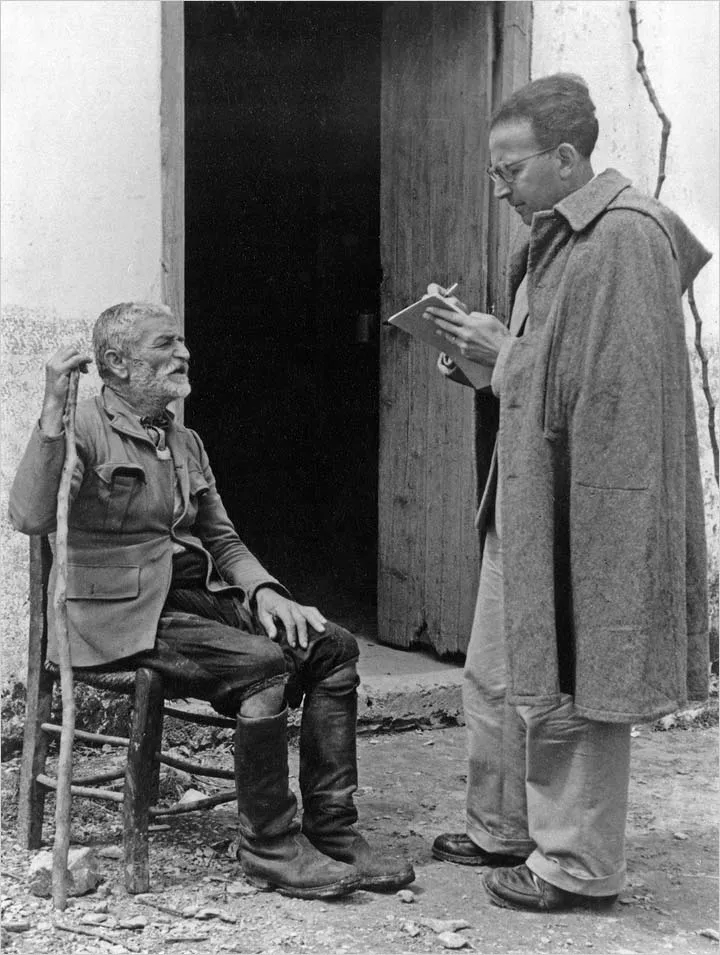
Samuel Baud-Bovy during a work session in Gonies (Crete) in 1954. Photo: Bertrand Bouvier
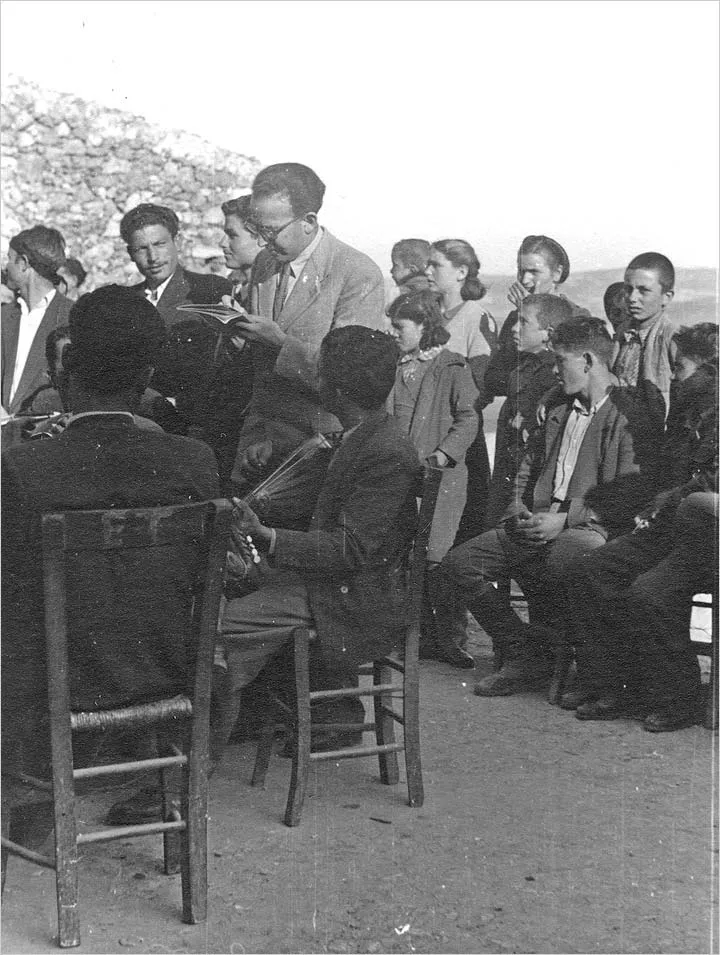
Samuel Baud-Bovy during a research mission in Gérgeri (Crete) in 1954
At the time of his death in 1986, the Samuel Baud-Bovy archive consisted of four collections: one on ethnomusicology, the largest of the group; another on Western classical music; one on modern Greek literature; and his correspondence with other personal documents.
In 1987, the entire archive was donated to the Geneva Conservatory of Music (GCM). Some of the correspondence and personal documents were then given to the Geneva Library. The Western classical music collection was integrated into the GCM library. The part related to the modern Greek literature was transferred to the library of the Modern Greek unit of the Faculty of Arts at the University of Geneva.
The ethnomusicology collection was transferred in its entirety to the MEG in March 2017.

Notebook of Samuel Baud-Bovy during his mission in Apolakkia (Rhodes, Dodecanese), in the 1930s
An inventory of this collection was made between 1987 and 1989 by Lambros Liavas (professor of ethnomusicology at the Faculty of Musical Studies of the School of Philosophy of the University of Athens) and distributed in the form of a hardback book, the Catalogue du fonds Samuel Baud-Bovy (186 pages), published in 1989.
The Samuel Baud-Bovy ethnomusicological collection includes original field recordings made on 76 magnetic tapes and 62 micro-cassettes. It is completed by Samuel Baud-Bovy's personal record library, comprising 162 commercialised traditional music records. These 300 phonograms are kept in the IAFM. The handwritten archives have been transferred to the archives of the city of Geneva.

Mission to Crete, 1954
The elements of this collection were gathered between 1954 and 1980. From a scientific and qualitative point of view, the most significant set includes the elements collected by Samuel Baud-Bovy during his missions to Crete in 1954 and 1973 (25 magnetic tapes, musical transcriptions and ethnographic data) and the music of Thrace that he recorded in Macedonia in 1979 (3 audio cassettes). The Melpo Merlier Folklore Music Archive, part of the Center for Asia Minor Studies in Athens, holds a copy of the 21 tapes produced in Crete in 1954.
The other elements of the collection come from the work carried out between 1956 and 1973 by Samuel Baud-Bovy's close collaborators who, under his impetus, undertook an exhaustive collection of the musical traditions of Crete and various regions of Greece.
Some of the field recordings were transferred to compact discs and DATs in the 1990’s by the GCM. About fifteen micro-cassettes were digitised at the MEG in 2017, in the framework of an internship carried out by Claire Gillot, then a student of the Master of Ethnomusicology (UNIGE, UNINE, HEM Geneva-Neuchâtel).

Thanks to Rudolf Mueller's advice, a grant application for the processing of this collection was submitted to, and positively received by, Memoriav - Association for the Preservation of Swiss Audiovisual Memory. Thus, the digitisation work could be completed in autumn 2019 by David Hadzis, whose United Music Foundation studio (Geneva) specialises in the digitisation and restoration of old and fragile recording media.
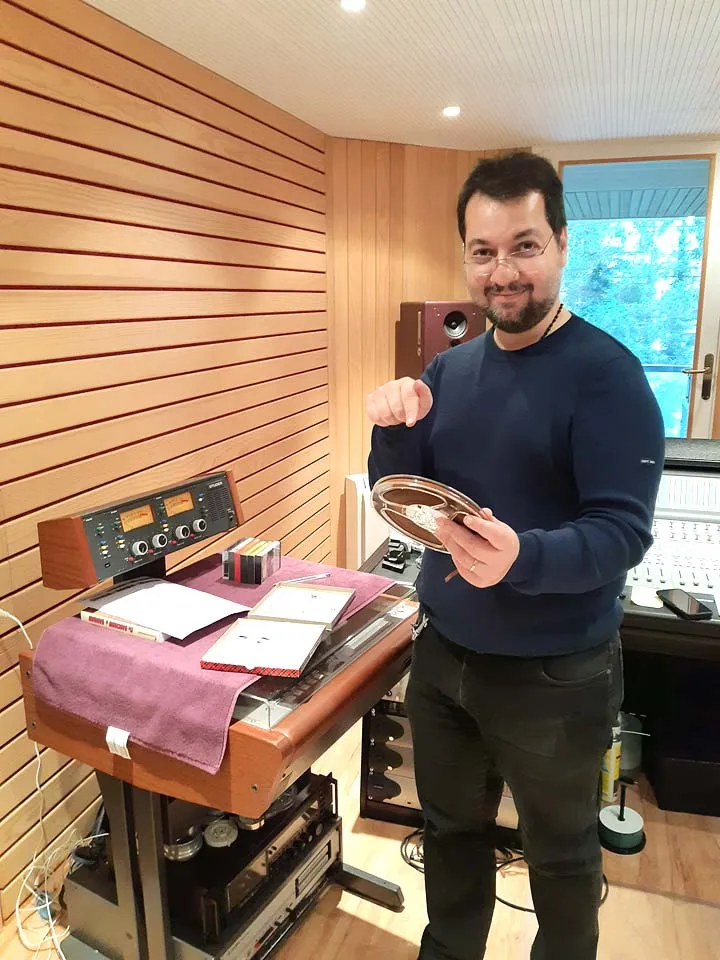
The digitisation of the magnetic tapes of the Samuel Baud-Bovy collection was done at the United Music Foundation studio by David Hadzis

Eirini Manolaki and Manolis Mourtzakis at the Archives of the City of Geneva
This financial support has also made it possible to recruit the musicologist Manolis Mourtzakis, from December 2019 to February 2020 as a scientific collaborator, to monitor the digitisation work and to carry out the indexing, cataloguing and documentation of the newly digitised phonograms.
The study and processing of this important archive is now continuing thanks to the work of Eirini Manolaki, as part of her Master's course in ethnomusicology. Her work consists of grouping the data (musical transcriptions, transcriptions of sung texts, field notes and recordings) into files accessible on the MusinfoAudio database and completing the cataloguing work.
Samuel Baud-Bovy collection : description of contents
1. Magnetic Tapes BD697 to Bd717 :mission in Crete in 1954
In April 1954, Samuel Baud-Bovy led a mission to Crete to record popular songs from all regions of the island. This mission represents the first comprehensive ethnomusicological work in Greece and is an important moment in the history of Greek music research.
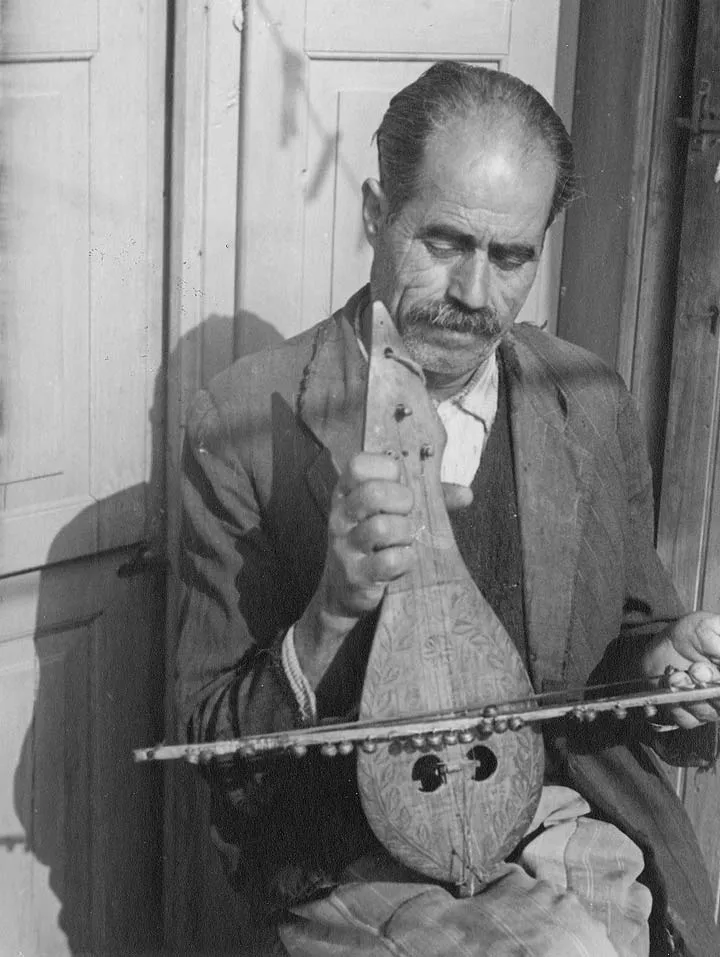
Lyra fiddle player Yiorgos Atsalis, Kritsa, Crete 1954
Two members of the Melpo Merlier Folklore Music Archive in Athens, Despoina Mazaraki and Aglaïa Ayoutanti, took charge of the preparation of the expedition. They visited Crete in the autumn of 1953, collecting information on the regions, repertoires, singers and instrumentalists.
The 1954 research team, under the direction of Samuel Baud-Bovy, consisted of Despoina Mazaraki, Aglaïa Ayoutanti, Manuel Baud-Bovy, son of Samuel Baud-Bovy, and Dominique Bron. Bertrand Bouvier, Samuel Baud-Bovy's student, and his wife Michelle, also accompanied the team. Two tape recorders were used as equipment during the mission. This technology allowed the recording of complete versions of many songs and a detailed musicological study.
The mission recorded 280 Cretan songs and dances. Apart from the recordings themselves, the Samuel Baud-Bovy collection also includes a large number of manuscripts held in the archives of the City of Geneva, organised in 33 folders. This material includes transcriptions, texts of the songs translated into French, notes by S. Baud-Bovy on the scales, rhythms and variations of the songs as well as reviews, correspondence between the members of the team and information on performers and repertoires.
S. Baud-Bovy emphasised that the aim of this mission was mainly to collect songs and instrumental music which were at the time being replaced by more recent repertoires and instruments. For this reason, the team interviewed mainly 'old' people, far from the academic world, and amateur musicians.
The first publication following this mission was the book Folk Songs of Western Crete, published in 1972. S. Baud-Bovy then continued the study of Cretan songs, leaving among his manuscripts rich material on lullabies, funeral songs, rhyming ballad melodies, songs from [E]rotokritos (a 17th Century novel written by Vincenzo Cornaro), narrative and wedding songs, instruments and dances. Several studies were presented at conferences, but most of this material remained unpublished until 2006.
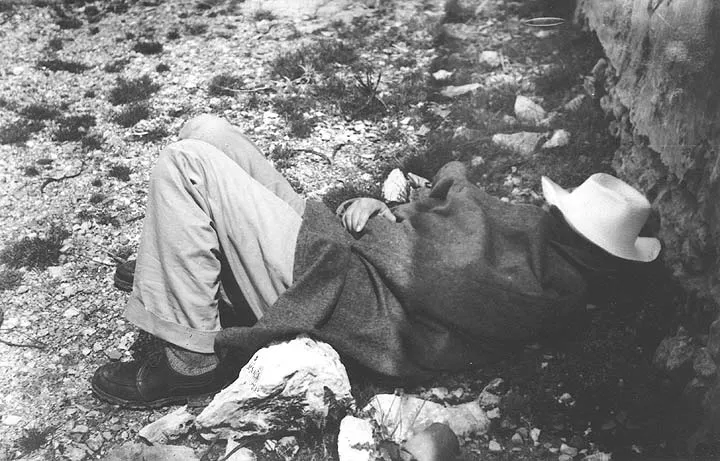
Samuel Baud-Bovy resting. Crete, 1954
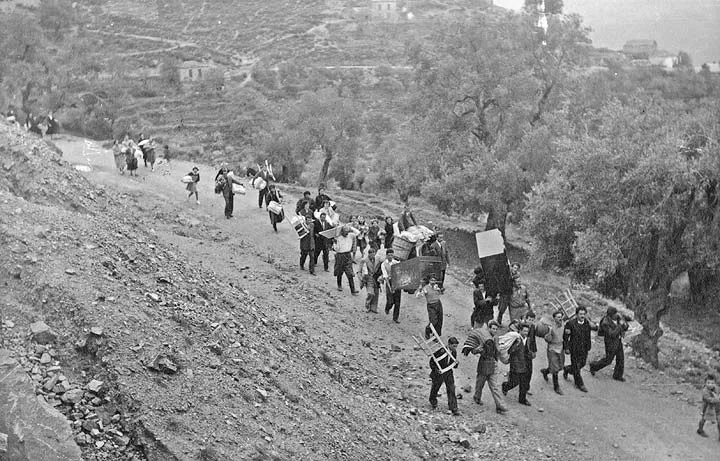
April 6th 1954, wedding in the Cretan village of Lakkoi
2. Magnetic tapes Bd732 to Bd738 : Mission of Despoina Mazaraki, Aegina, 1956
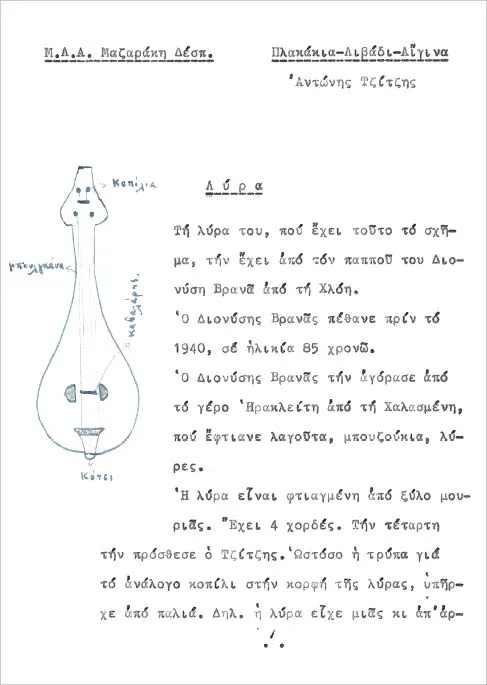
Notes by Despoina Mazaraki. Aegina, 1956. MEG, S. Baud-Bovy collection, Dossier III 2
This collection contains 90 songs recorded in Aegina (Greece) by Despoina Mazaraki, a collaborator who took part in the work of the Melpo Merlier Folklore Music Archive Centre. The mission took place in September 1956 and Louis Berthe was in charge of the sound recording. Some of these songs were published by the Melpo Merlier Folklore Music Archive in the form of the double 33 rpm vinyl disc "Songs of Aegina" released in 1990, partly reissued on CD in 1997 (MLA CD 5).
The recordings include both a capella songs and accompanied songs. The instruments recorded are the violin, the santuri zither and the laouto lute.
Among the genres represented are wedding songs, couplets, table songs, lullabies, carnival songs and sailor songs (sung while working on trawlers).
The collection is accompanied by typescripts in which Despoina Mazaraki provides information on the villages, performers, recording locations and song texts. A 27-page document, integrated into the manuscripts of the Samuel Baud-Bovy archive, includes testimonies of informants and various information on the customs of Aegina, collected by the researcher.

Description of the musical tracks on tape BD746 recorded by R. Looser at Agoriani (Eptalofos) and Arachova, at the foot of Mount Parnassus (central Greece). MEG/ S. Baud-Bovy collection, manuscripts.
3. Magnetic tapes BD746 and BD747 : Recordings by Ralf Looser, Central Greece, 1956
Tapes BD746 and BD747-1 show various recordings made by Ralf Looser, a collaborator of S. Baud-Bovy.
Those on BD746 were made in 1956 in Agoriani and Arachova (Central Greece). They include tsamikos music, a popular dance, shepherd's songs and "cleftic" songs, a repertoire that interested S. Baud-Bovy.
BD747-1 presents a dozen songs and other vocal repertoires (lullabies, nursery rhymes), recorded in Samos in 1956, followed by various pieces of Turkish music from Trabzon (Black Sea) and Erzerum (Central Anatolia).
Tape BD747-2 is a montage of excerpts from tapes of the 1954 mission (Crete) and recordings made in 1956 by Ralf Looser.
4. Magnetic tape BD758 : Recordings by Wolf Dietrich, Thessaly, 1969
Tape BD758 presents ten Vlach songs, recorded in Thessaly (Panagia) on 1 June 1969 by Wolf Dietrich. With the exception of tracks 7 and 8, these songs are in the unwritten Vlach language, a language derived from Latin.

Description of the contents of magnetic tape BD758 recorded by W. Dietrich in Thessaly. MEG/ S. Baud-Bovy collection, manuscripts
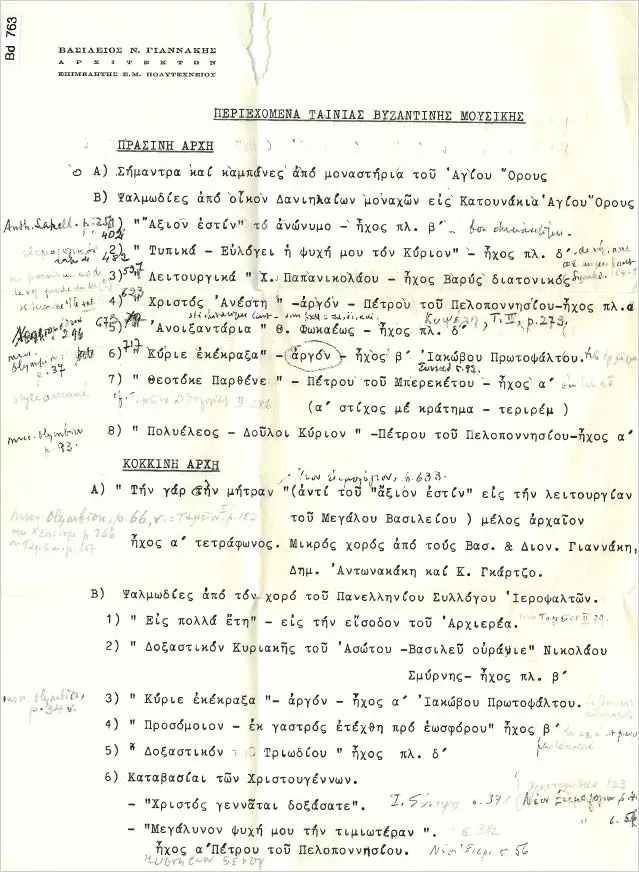
Description of the contents of magnetic tape BD763 recorded by V. Yiannakis at Mount Athos. MEG/ S. Baud-Bovy collection, manuscripts.
5. Magnetic tape BD763 : Recordings by Vasileios Yiannakis, Mount Athos, 1961-62
Tape BD763 presents mainly Byzantine psalmody (ecclesiastical music) recorded by Vasileios Yiannakis, probably around 1961-1962.
The tracks on BD763-1 were recorded in a monastery on Mount Athos.
BD763-2 includes psalmodies sung by the choir of the Hellenic Chant Association (tracks 2-11). Track 1 is sung by a small choir, possibly including V. Yiannakis. Track 12 is a Turkish song sung by a woman and track 13 is probably a liturgy from a Turkish mosque.
6. Microcassette MC957 : Lecture by Samuel Baud-Bovy
The lecture is about Greek mirologists (funeral songs). S. Baud-Bovy presents data on the representations linked to death in Greece through the prism of funeral songs from various regions of the country.
The Samuel Baud-Bovy collection holds a rich collection of Greek mirologists, recorded by himself or by his collaborators in Crete, Aegina, the Dodecanese and several regions of mainland Greece.
In the manuscripts of the collection, S. Baud-Bovy has gathered transcriptions, poetic texts, musicological analyses of the mirologists and several published or unpublished texts.